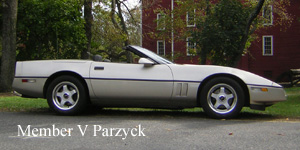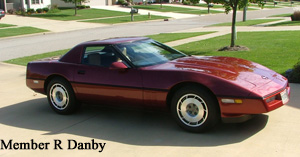 "More than 110 million cars and trucks have worn the Chevy bowtie since Louis Chevrolet gave his name to our company three-quarters of a century ago,” said Chevrolet general manager, Robert D Burger. “And for some 50 of those years, Chevrolet has been America’s favorite, an astonishing record that extends virtually unbroken all the way back to the 1920s.”
"More than 110 million cars and trucks have worn the Chevy bowtie since Louis Chevrolet gave his name to our company three-quarters of a century ago,” said Chevrolet general manager, Robert D Burger. “And for some 50 of those years, Chevrolet has been America’s favorite, an astonishing record that extends virtually unbroken all the way back to the 1920s.”While Corvette has been around for less than half of the last 75 years of Chevrolet history, it has done more than its share in making the Chevrolet nameplate so popular with new car buyers. Of course Corvette sells well on its own, but think of all the people it brings into Chevrolet showrooms who leave with something less expensive or more practical!
For 1987, Corvette is visually unchanged with the model year’s new features being in the areas of performance, convenience and reliability. In future years, collectors are really going to need to know their stuff to tell on 1980s Vette from another. This isn’t necessarily bad. Other world-class cars have been produced in this manner for many years.
The 1987 Corvette features a new, improved version of the workhorse 5.7 liter Tuned Port Injection (TPI) V8. The big improvement is in the form of anti-friction, roller-hydraulic lifters. Efficiencies due to friction reduction are basically derived from the use of roller contacts with the camshaft lobes in place of the previous sliding foot contact. Anti-friction characteristics are further exploited by the use of 18 needle roller bearings to support the main roller of each lifter. Roller lifters are worth about a three percent fuel economy increase and maybe as much as four horsepower on a maximum output curve. Other hardware changes in the valve train total up to what Chevrolet calls “a low-friction, low-noise and improved-durability system.”
Will the new Vette’s performance make it outpace last year’s model? Will, if the cars are tuned identically, carry an identical amount of the same fuel, are driven by drivers of the same caliber who happen to be of identical weight and height, and are equipped with the same Z52 suspension package (optional on 1987 Coupes), maybe. Otherwise we’re talking pretty much the same machine as last year, just a little better.
Also new is an optional, electronically monitored, low tire pressure indicator system that alerts the driver to low air pressure in any tire. Wheel modules, fastened to the metal rim inside each tire, contain a hermetically sealed pressure sensor and a radio transmitter powered by a long-life “piezo” power generator. The generator converts the existing mechanical energy of the moving wheel to electrical power, without benefit of batteries, external wires or connections. The entire package weighs less than two pounds and, according to the manufacturer, is virtually maintenance free.
For those who are wondering how the low tire pressure warning system will affect tire balance, a counterweight mounted directly opposite each wheel module should leave balance unaffected.
If air pressure in any tire drops by more than one pound per square inch below a pre-set level, the transmitter activates a dash-mounted warning light. The warning system also included a feature to alert the driver if a wheel module malfunction occurs.
Other changes to the 1987 Corvette are minimal. Passengers get the option of the same six-way power seat adjuster Vette drivers have enjoyed. Drivers get an optional lighted visor vanity mirror (just what every yuppie with a curl out of place has been waiting for one supposes). Key components carry identification for theft deterrence. And for those who truly appreciate the miniscule, the unimportant, the mundane, the overdrive engage light has been positioned below the tach curve, and the generator low-out-put indicator moves to the driver information module in the center console.
There you have it. For 1987, a little changed Corvette. Nothing wrong with that of course. If every car looked and ran like Corvette, they wouldn’t change so often either.
There is one other option available, but it is not your everyday, anyone can have it option. It’s RPO-B2K, the Callaway Twin Turbo! This option package is destined to join the ranks of such milestones as L88 and the rare Z06.
The car is only available through about 40 Chevy dealers (12 in California) and current production is only one per week with maximum output, depending on orders, of 200-250 for the year.
A Corvette ordered with the Callaway option is shipped from Bowling Green directly to Callaway Engineering in Old Lyme, Connecticut. There, Reeves Callaway and staff pull the stock engine and install a new one built with EM-supplied 4-bolt main block and forged crank. Each block is line bored, honed, blueprinted and balanced. Cosworth forged aluminum pistons form England, a high output Melling oil pump, a separate sump pump to draw oil from the turbo sumps and twin IHI RHB52 turbo chargers are just a few of the improvements.
This Corvette will do 0-60 mph in 4.6 seconds and the ¼ mile times of 13.2 seconds at 109.1 mph. The 345 hp Vette will have an estimated top speed of 175 mph.
This is one fantastic option and except for a few small outward signs like air intakes in the hood, wide flat exhausts and a Callaway nameplate on the B-pillars, you wouldn’t detect what an awesome performer this Corvette is.
The option will cost you almost $20,000 over the sticker price of the standard Corvette. But if only a dozen cars get this factory option it could be worth a lot more in the future just because it was so rare.
| 1987 Corvette Specifications |
|
| Model |
|
| Coupe |
1YY07 |
| Convertible |
1YY67 |
| Power Train |
Rear Wheel Drive |
| Engine Code |
L98 |
| Engine Type |
V8 |
| Carburetor |
TPI |
| Liters |
5.7 |
| Cubic Inches |
350 |
| Horsepower |
240@4000 rpm |
| Torque |
345@3200 rpm |
| Axle Ratio |
|
| Manual 4-speed |
3.07:1 |
| Automatic 4-speed |
2.59:1/3.07:1 |
| Fuel Capacity |
20 gallons |
| Curb Weight |
|
| Coupe |
3216 pounds |
| Convertible |
3279 pounds |
| Wheelbase |
92.6 inches |
| Overall Length |
176.5 inches |
| Internal Space |
|
| Leg Room |
42.6 inchesz |
| Hip Room |
49.3 inches |
| Cargo Space |
|
| Coupe |
17.9 cubic feet |
| Convertible |
6.6 cubic feet |
| Brakes |
four-wheel disc |
| EPA MPG Label Range |
|
| City |
16 miles per gallon |
| Highway |
25 miles per gallon |
| Combined |
19 miles per gallon |